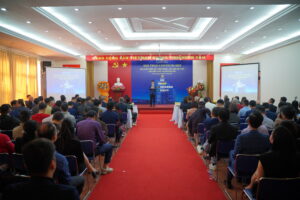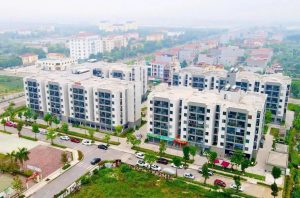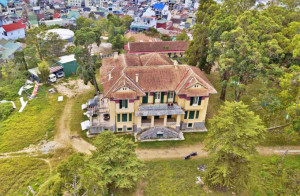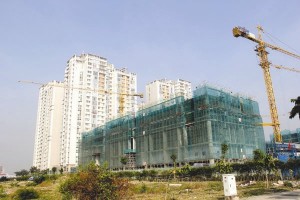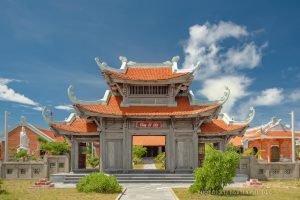Công bố quốc tế trong lĩnh vực kiến trúc, xây dựng (Tuần 2 tháng 9-2021)
Trong số này chúng tôi xin giới thiệu tới quý độc giả những nội dung chính của các công bố quốc tế đăng tải trên ScienceDirect và Springer Nature do Cục Thông tin khoa học và công nghệ quốc gia (NASATI) mua quyền truy cập như sau:
Quy hoạch đô thị:
– Xem xét các phương pháp tiếp cận, cơ hội và định hướng tương lai để cải thiện khí động học của các tòa nhà cao tầng có mặt tiền thông minh
– Mô phỏng không gian địa lý về tiềm năng mật độ vùng lân cận đô thị
– Cải tạo xây dựng ở cấp huyện – Bài học kinh nghiệm từ các nghiên cứu điển hình quốc tế
– GraphCrypto: Phương pháp bảo mật dữ liệu thế hệ tiếp theo hướng tới xây dựng thành phố thông minh bền vững
– Quản lý thành phố thông minh thông qua phương pháp DMADICV-6 sigma: Khung khái niệm dựa trên đánh giá
– Ảnh hưởng của các đặc điểm hình thái đô thị đến môi trường nhiệt
– Ra quyết định trong phát triển đô thị: Việc áp dụng phương pháp đánh giá kết hợp cho một khu vực quan trọng ở thành phố Turin (Ý)
– Chính sách phát triển theo định hướng đổi mới sẽ ảnh hưởng như thế nào đến việc sử dụng đất đô thị bền vững: Bằng chứng từ 230 thành phố của Trung Quốc
– Phương pháp bố trí cây để tạo bóng mát cho khu vực dành cho người đi bộ: Nghiên cứu về sự thoải mái nhiệt ở Bilbao (Bán đảo Bắc Iberia)
– Đánh giá khả năng phục hồi của hệ sinh thái đô thị bằng cách sử dụng khung DPSIR và mô hình ENA: Một nghiên cứu điển hình về 35 thành phố ở Trung Quốc
Khoa học và công nghệ trong lĩnh vực kiến trúc, xây dựng:
– Phát triển hệ thống quản lý vòng đời tòa nhà hỗ trợ BIM cho chủ sở hữu: Kiến trúc và tình huống
– Khám phá các đối tượng xây dựng thông minh – kỳ tích ứng dụng blockchain trong quản lý chuỗi cung ứng xây dựng
– In 3D vữa có sợi liên tục: Nguyên lý, tính chất và tiềm năng ứng dụng.
– Bố cục gạch tối ưu của tường xây dựa trên thuật toán tiến hóa thông minh và mô hình thông tin tòa nhà
– Kiểm tra tự động trong thiết kế tòa nhà chuyên dụng cho chăm sóc sức khỏe
– Mô hình học máy để dự đoán giá trị còn lại của thiết bị xây dựng hạng nặng: Đánh giá cây quyết định đã sửa đổi, hồi quy LightGBM và XGBoost
– Đánh giá tự động về sự sẵn sàng của cơ sở hạ tầng cho các phương tiện tự hành
– Một chỉ số hiệu suất mới để đánh giá khả năng học tập của các tòa nhà thông minh
– Nghiên cứu thử nghiệm về một phương pháp mới để cải thiện khả năng chống sập tiệm tiến của khung BTCT sử dụng các thanh cốt thép cục bộ
Vật liệu xây dựng:
– Nghiên cứu thực nghiệm các mối nối ống lót bằng vữa chịu uốn cho các nhà mô-đun thép
– Các kỹ thuật mới để tiết kiệm năng lượng của các tòa nhà bền vững bằng cách sử dụng vật liệu thay đổi pha
– Nghiền bê tông dựa trên công nghệ phóng xung điện áp cao
– Ảnh hưởng của graphen oxit đến tính thấm của vật liệu xi măng: Thực nghiệm và lý thuyết
– Một hỗn hợp titania / graphene mới được ứng dụng để gia cố các tính chất vi cấu trúc và cơ học của xỉ hoạt hóa kiềm
– Mô hình dự báo cho các tính chất trạng thái cứng của silica fume và bê tông nước biển gốc tro bay kết hợp xỉ silicomangan
– Phân tích biến đổi sức căng của các phần tử gỗ nhiều lớp trong điều kiện độ ẩm theo chu kỳ
– Vật liệu gốc xi măng: Các hoạt động Pozzolanic của các chất bổ sung khoáng chất bị tổn hại do sự hiện diện của các oxit phản ứng
– Kết hợp bô xít hoạt tính để tăng cường các đặc tính kỹ thuật và cấu trúc vi mô của vật liệu tổng hợp vữa geopolymer tro núi lửa
– Tổng quan về tác dụng gấp đôi của phụ gia kết tinh trong vật liệu gốc xi măng: từ chất làm giảm độ thẩm thấu đến chất kích thích tự phục hồi
Xin trân trọng giới thiệu!
QUY HOẠCH ĐÔ THỊ
- Review of approaches, opportunities, and future directions for improving aerodynamics of tall buildings with smart facades
Sustainable Cities and Society, Volume 72, September 2021, 102979
Abstract
The demand for tall buildings has increased over the past decades for cultural, financial, and technological reasons. Such slender structures are more flexible and vulnerable to wind-induced vibrations. Additionally, wind speed exponentially increases with height, resulting in larger wind loading on higher levels and complex turbulent regimes. Such effects call for more innovative approaches to enhance the resilience of tall buildings while accounting for the sustainability implications. Current methodologies to control the vibrations using auxiliary dampers are typically limited in their applicable bandwidth. The aerodynamic modifications are specific to a particular wind direction and characteristics and cannot adapt to the changing climate or that of flow regimes due to the new construction in the proximity of the target building. There have been major advances in using secondary façades to achieve sustainability through ventilation and energy-saving applications around the world. These advances have resulted in the development of adaptive facades for architectural and energy applications. This review paper discusses the available approaches and potential opportunities to utilize the existing adaptive façade system capabilities (for energy applications) to alter building aerodynamics. For this purpose, the paper concisely discusses aerodynamic modification, surface roughness effects, available bio-inspired approaches, and potential morphing material capabilities to provide valuable insights into understanding the flow-control mechanism of such systems, potentially leading to innovative designs of façade systems. Opportunities have been identified to combine this concept with smart technologies to develop smart façades with the aerodynamic performance that leads to mitigating wind-induced vibration in tall buildings. The review of existing research on this topic opens up opportunities for enhancing the use of facades as active, dynamic, and smart systems that not only enhance the performance of the tall buildings under wind-induced vibrations but also can result in long term energy saving, leading to more resilient and sustainable communities.
- Building renovation at district level – Lessons learned from international case studies
Sustainable Cities and Society, Volume 72, September 2021, 103037
Abstract
Renovation at district scale is a key strategy to reduce CO2 emissions by optimising the implementation of renewable energy sources and taking advantage of economy of scale. This paper focuses on analysing good practice examples on energy renovations at district scale. The paper adapts a qualitative research methodology in four phases, including the multi-perspective analysis of nine exemplary renovation projects in six European countries, including identification of drivers and barriers of different stakeholders.
It is found that the drivers for a district renovation are not restricted to energy savings, but typically also include improving the overall quality of life as well as the image and economic value of a district. Moreover, the need for financial models that can alleviate split-incentive problems between investors and resident organizations is identified.
Barriers for carrying out a district renovation include that there is a need to comply with energy standards, that the renovation scope had to be limited to avoid a noticeable rent increase and that resettling of tenants during the renovation is often not possible.
Lessons learned include that good communication amongst the different stakeholders, especially with residents, plays a key role for the success of the project. Furthermore, a strong leadership is needed to coordinate activities due to the great number of stakeholders.
- Geospatial simulation of urban neighbourhood densification potentials
Sustainable Cities and Society, Volume 72, September 2021, 103068
Abstract
Although densification of urban areas is being proposed as a sustainable urbanisation strategy, frameworks for detailed large-scale analysis of densification potentials and their evaluation are lacking. A geospatial simulation framework is presented to assess and evaluate densification potentials at the neighbourhood level of already built-up residential areas. The focus is on post-war neighbourhoods, which are particularly promising for sustainable densification. Neighbourhoods are localised using geospatial analysis and based on literature and architectural designs, potentials are estimated for different neighbourhood archetypes and densification strategies. Potentials are simulated at a national scale using supervised archetype classification. The embeddedness into current mobility infrastructure is used as a proxy for evaluating the sustainability of neighbourhood densification. The developed framework is tested for Switzerland. Depending on the densification strategy, the simulated additional inhabitants for populating post-war urban neighbourhoods range between 4–15 % of the current population. More than half of this potential is located in central areas and is well connected by public transportation. The presented approach is suitable for assessing spatially explicit densification potential and for prioritising densification locations. We show that in countries with a high number of post-war neighbourhoods in well-connected locations, considerable densification opportunities could be realised in already built-up residential areas.
- GraphCrypto: Next generation data security approach towards sustainable smart city building
Sustainable Cities and Society, Volume 72, September 2021, 103056
Abstract
Data confidentiality and integrity are essential security goals in the data communication in the smart city or similar applications. Despite significant changes in modern data communication systems and devices, the cryptosystems are still the primary option to achieve data security. Several cryptosystems have been developed, implemented and standardized to date. However, there is always a continuous demand for a new cryptosystem for providing security during data communication. In this paper, a novel symmetric cryptosystem is presented for achieving data confidentiality. The proposed cryptosystem is a graph-based system, where an algebraic structure of directed graphs along with a novel operation is defined to provide the base of the cryptosystem. Here, a directed graph represents a plaintext, a ciphertext, and a secret key as well. The defined operation is used for encrypting and decrypting plaintext and ciphertext graphs. The proposed cryptosystem provides a simplified transformation process and representation of plaintext to plaintext graph. The correctness of the proposed cryptosystem is validated, and also shown that the conventional brute-force approach to obtain the key from either plaintext or ciphertext is exponential and this computational time is significantly higher than AES. This implies that the proposed cryptosystem is highly secured against this attack. The proposed cryptosystem is implemented and compared with AES and the results infer that it incurs a marginally higher execution time than the AES for larger plaintext due to the involvement of matrix operations.
- Managing smart cities through six sigma DMADICV method: A review-based conceptual framework
Sustainable Cities and Society, Volume 72, September 2021, 103022
Abstract
Smart cities are complex endeavors that present several management challenges. The current study proposes a conceptual framework based on Six Sigma for managing smart cities. DMADICV is a novel method proposed in the current study for Six Sigma. The proposed DMADICV framework consists of six key constructs: Define, Measure, Analyze, Design, Improve, and Control & Verify. These constructs are used as layers in smart cities, and relevant literature is reviewed to highlight the key factors and groups related to each layer. A conceptual framework is provided for smart city management and an assessment mechanism presented for measuring and testing the performance of smart city integrated processes. This is achieved by measuring and controlling the cost of quality non-conformance, right documentation in the first time, and timely implementation of control measures, the activity processing index, and quality controls. Improvement construct has a percentage of 35.67 % share in the DMADICV framework followed by define (16.76 %), design (15.52 %), control & verify (14.33 %), measure (10.08 %), and analyze (8.15 %). The top ten factors for managing smart cities through the Six Sigma method include process quality improvement, organizational development, process analysis, quality management, cost control, DMAIC, change management, project management plan, waste reduction, process quality measurement, and value creation, respectively. The DMADICV framework and its dynamic relations are shown through a system model and its key groups represented in layers of the smart cities whereby the city governance and management teams can provide services to their smart citizens effectively and efficiently. The proposed DMADICV method and associated smart city management framework are a humble addition to the body of knowledge that can be adopted and utilized in other knowledge fields.
- Influence of urban morphological characteristics on thermal environment
Sustainable Cities and Society, Volume 72, September 2021, 103045
Abstract
Variation in urban microclimate is closely related to the three-dimensional characteristics of cities. To reveal the influence of urban spatial forms on land surface temperature (LST), the spatial distribution of LST and five urban morphology indicators were analyzed, namely floor area ratio (FAR), plot ratio (PR), absolute rugosity (Ra), mean aspect ratio (λc), and sky view factor (SVF). Based on correlation analysis and numerical simulations, the influence of three-dimensional characteristics on the urban thermal environment of Dalian, China was then analyzed. The results showed that in Dalian, LST ranged from 23.2–50.7 °C, and Moran’s I was 0.94, indicating that LST presents a strong spatial positive correlation. The buildings in the study area were mainly multi-story and high-rise buildings and mostly distributed in a medium-density area. LST exhibited the highest positive correlation (correlation coefficient = 0.569) with FAR and was negatively correlated with SVF (correlation coefficient =−0.270). The simulation results showed that in the medium density range (FAR <0.6), an increase in FAR changed the wind speed, thereby affecting the urban thermal environment. The results demonstrate the influence of urban morphology on the thermal environment and provide scientific ideas for future planning and construction of “cool cities”.
- Decision making in urban development: The application of a hybrid evaluation method for a critical area in the city of Turin (Italy)
Sustainable Cities and Society ,Volume 72, September 2021, 103028
Abstract
Smart cities and sustainable neighbourhoods are increasingly gaining more attention within policy decisions on urban transformations. In this context, Decision-Makers (DMs) need evaluation methodologies able to support the definition of policies and actions for the future of cities, that focus on a higher degree of life quality and new needs. In this paper, an integrated framework is proposed which combines the Stakeholder Analysis, the STEEP and SWOT analyses (STEEP + SWOT), the Scenario Building and the Multicriteria Decision Analysis approach (MCDA) which can be used to envision sustainable future scenarios for an underdeveloped area in Northern Italy. The adoption of integrated methodologies facilitates the analysis of each phase of the decision problem, from its early stage to the selection of the most suitable scenario according to the context and the stakeholders engaged. With this perspective, the present research is a guiding tool for DMs for the design of transformation/regeneration scenarios with a long-term perspective of sustainable cities and neighbourhoods. From the results obtained, it is possible to build new and unexpected scenarios by combining the main opportunities and strengths of most suitable alternatives.
- How will innovation-driven development policy affect sustainable urban land use: Evidence from 230 Chinese cities
Sustainable Cities and Society, Volume 72, September 2021, 103021
Abstract
Government policy has a significant effect on rural–urban land conversion, ultimately affecting sustainable urban land use. Unlike most studies that have centred on the effects of local land-use policies, such as regulations and taxes, the present study investigates the effect of the innovation-driven development policy initialised recently by China on urban land growth at the national level. Although the geography of innovation, high-tech agglomeration and sectoral restructuring are place-based activities, existing evidence shows several links between urban innovation and urban land growth. However, only a few empirical studies have examined their relationships to date. Thus, we aim to determine the effect of urban innovation on the size and the spatial distribution of urban land using a statistical dataset from 2007 to 2015 and a spatial data source at two-time points for 230 Chinese cities. We employ three fixed effects models to control for the possible correlation between independent variables and unobservable city-level effects. Our results indicate that urban innovation has indeed driven urban land growth but does not make the urban landscape more scattered than before. Further examinations suggest that the urban innovation effect varies across the whole country, and the innovation-urban land growth connection relies on the geographic location rather than the economy size.
- Tree layout methodology for shading pedestrian zones: Thermal comfort study in Bilbao (Northern Iberian Peninsula)
Sustainable Cities and Society, Volume 72, September 2021, 102996
Abstract
The need to reduce heat-related thermal stress calls for a reassessment of shading in outdoor urban spaces with the aim of achieving more habitable and sustainable cities. In this research, a methodology based on mathematical formulas is presented and applied to determine the most appropriate geometric properties and position of the trees to be planted in an urban canyon, based on its E-W solar orientation and the height of the buildings. The methodology relies on shading the largest possible surface area of the pedestrian zones of a canyon through the appropriate autochthonous tree species, but it also requires a thermal-comfort evaluation of tree transmissivity. The case study is validated in Bilbao, where a combination of measurement and modelling techniques (Solweig model) are used to verify suitable guidelines for urban design. The results will be of interest to architects and city planners for decision-making when integrating trees, so that urban thoroughfare development can improve thermal comfort in actual or new canyons. The methodology could be applied to other climatic regions, although some of the parameters used both for the evaluation of the heat-related critical moments and in the formulas should be adapted.
- Evaluating urban ecosystem resilience using the DPSIR framework and the ENA model: A case study of 35 cities in China
Sustainable Cities and Society, Volume 72, September 2021, 102997
Abstract
Rapid urbanization and large-scale industrialization in China have produced problems that affect resources, the environment, and local ecology, which are obstacles to urban ecosystem resilience. Ecosystem resilience is critical for recovery from adverse natural events and the security of urban ecosystems. In this paper, we constructed the evaluation indexes of urban ecological resilience systems (UERs) using DPSIR framework to quantify urban ecological resilience index (UERI) for 35 major cities in China, and we evaluated the sustainability of UER networks using ecological network analysis. The results show that: (1) UERI generally increases annually, but it gradually decreases geographically from developed coastal areas to developing inland areas; (2) factors that affect the DPSIR components Drivers, State and Responses significantly increase UERI, and factors that affect Pressures and Impact decrease UERI; all paths of DPSIR passed the causal hypotheses test; (3) the ideal value for resilience of an urban ecosystem network was 0.550; we found that resilience in 2005 was 0.659, and in 2010 was 0.512 but in 2015 was 0.462 (<0.550). As ecosystem vulnerability and adverse ecological risks continue to increase, it is critical for cities to transform themselves to increase ecological security and become more resilient.
- Analysis and visualization of data obtained from camera mounted on unmanned aerial vehicle used in areas of urban transport
Sustainable Cities and Society, Volume 72, September 2021, 103004
Abstract
Nowadays, it is practically impossible to find a public place, where a person or object would not be under constant camera observation (mainly used to monitor traffic and to increase safety). Interpretation of such repositories, due to the huge amount of data, is not an easy task. Thus there is a need to introduce an intelligent processing systems that, through algorithmic image analysis, are able to detect e.g. situations worth of attention. The article presents methods of data acquisition from cameras mounted on unmanned aerial vehicles (UAV) and their further analysis, which may be used to improve urban transportation systems and its sustainability. The worked out data concern the situation of urban transport in points of intersection of national and local roads. The analysis of the road traffic concerning local road restoration, causing road closure was achieved using image processing and analysis algorithms. The data was obtained from unmanned aerial vehicle flights in critical city locations. Result of this paper may be used in the future together with the data from existing intelligent transportation systems (a fusion of such data will be needed). The application of used methods will allow to extend and support the existing approaches to manage public and freight transport in cities.
- Unveiling transit mobility structure towards sustainable cities: An integrated graph embedding approach
Sustainable Cities and Society, Volume 72, September 2021, 103027
Abstract
Detecting urban mobility structure, i.e., segmenting urban areas into disjoint clusters with similar mobility patterns, can facilitate our understanding of how a city is organized and how different parts of a city interact with each other, which underpin informed decision-making in achieving sustainable urban transportation development and resilient society. In this study, we propose to tackle a novel transit mobility structure detection problem, which hinges on high-level mobility patterns that characterize collective movement dynamics across the study region. To this end, we propose a machine learning-based approach to discover meaningful urban mobility structure using big transit data. We contend that both transit mobility patterns and local urban function information should be considered during the detection of transit mobility structure. By integrating different sources of urban data, we model the network of transit mobility as an attributed graph: local static urban functions are described by attributed features for graph nodes whereas travel dynamics are captured via a transit mobility pattern matrix. Similarities of both attributed features and transit mobility patterns are jointly embedded to derive compact low-dimensional vector representations via graph auto-encoder. Mobility structure is then extracted using unsupervised clustering and gap statistics. The proposed approach is capable of synthesizing both mobility and static information in a data-driven manner, preserving original urban topological structure and resident movement dynamics. The proposed approach was evaluated using real-world transit data collected in Shenzhen City, China. Experimental results and analyses demonstrate that the proposed approach has the applicability of unveiling meaningful transit mobility structure in large metropolitan areas. The detected mobility community maps present a holistic overview of public transit movement structure, enabling decision makers to make informed decisions on sustainable urban development and transit management.
- Impact of land use types on the spatial heterogeneity of extreme heat environments in a metropolitan area
Sustainable Cities and Society, Volume 72, September 2021, 103005
Abstract
Global climate change has intensified extreme climate events such as torrential rain/snow, heat waves, and droughts. Among climate disaster events, extreme heat can bring long and intensified heat waves and seriously impact the human living environment and ecological habitat. However, extreme heat may have inconsistent impacts on various geographical environments, and such extreme heat might impact human health differently among various locations and climate zones. Therefore, this study applies Moderate Resolution Imaging Spectroradiometer (MODIS) data to produce 2014–2018 land surface temperatures and further applies spatial analysis to categorize areas into absolute and relative heat areas in the Taipei metropolitan area in Taiwan. A comparative analysis is then conducted based on ordinary least squares (OLS) and geographically weighted regression (GWR) to explore the spatial heterogeneity of changing heat environments in the study area. Although the OLS results show that mixed use has the greatest influence on heat, whereas green space and barren land have the highest negative effect on heat, the GWR analysis shows that the coefficients of every land use type demonstrate different spatial patterns. These spatial patterns can be applied as a reference for the mitigation plans to reduce the effects of heat.
- Meta-regression framework for energy consumption prediction in a smart city: A case study of Songdo in South Korea
Sustainable Cities and Society, Volume 72, September 2021, 103025
Abstract
Nowadays the concept of smart city has gained in popularity in urban studies. A smart city collects diverse information to monitor and analyze urban systems, such as energy management. It is crucial for smart cities to monitor energy efficiency to be sustainable. In this study, we search to expose the possibilities offered by the energy data of Songdo, a South Korean smart city. First, we have highlighted the ability of Songdo to generate energy data. Second, we used those data to predict its evolution. As a result, we develop a short-term stacking ensemble model for energy consumption in Songdo, focusing on a three-months-ahead prediction problem. To obtain this result, first we design a baseline regressors for the prediction, second, we apply a three-combination of each best model of the base regressors, and finally, a weighted meta-regression model was applied using meta-XGBoost. We call the resulting model stacking ensemble model. The proposed stacking ensemble model combines the best ensemble networks to improve performance prediction, yielding an R2 value of 97.89 %. The results support the effectiveness of the ensemble networks, which use Artificial Neural Networks (ANN), CatBoost and Gradient Boosting. This study also shows that the weighted meta model outperforms several machine learning models in terms of R2, MAE and RSME.
- Ranking cities based on their smartness level using MADM methods
Sustainable Cities and Society, Volume 72, September 2021, 103030
Abstract
Urbanization and its consequent problems are urging cities to become smarter. Developing smart cities calls for a suitable while comprehensive assessment framework to assist city planners and decision-makers to suggest future directions for cities on how to become smarter by evaluating the smartness of cities. In this regard, this study follows two primary purposes. First, we investigate the concept of “smart city” and its pillars. Second, we develop a smartness assessment framework by considering both subjective and objective criteria and employing six effective multi-attribute decision making (MADM) methods. A linear assignment model is formulated to find an aggregated ranking vector using the ranking vectors obtained from these MADM methods. Then, as a case study, five out of the most important cities in Iran are compared and evaluated by adopting the proposed framework. Furthermore, different scenarios are introduced to investigate the sensitivity of results to the distribution of the importance weights amongst criteria. The results demonstrate the significance of the governmental, economic, and environmental indicators in evaluating the smartness of cities. Moreover, Tehran, the capital city of Iran, obtains the best ranking in all the methods and weighting scenarios, while Tabriz has the worst ranking among the cities under study.
KHOA HỌC VÀ CÔNG NGHỆ TRONG LĨNH VỰC KIẾN TRÚC, XÂY DỰNG
- Developing a BIM-enabled building lifecycle management system for owners: Architecture and case scenario
Automation in Construction, Volume 129, September 2021, 103814
Abstract
Given the fragmented nature of the architecture, engineering, construction, and operation (AECO) industry, building lifecycle management (BLM) involves bringing together multidisciplinary teams and integrating lifecycle processes of buildings. Despite the increasing use of information technologies and software tools by property owners, several barriers in BLM implementations remain, such as information silos, low data interoperability, poor cross-party coordination, and the mismatch of existing commercial solutions and user requirements. To deal with these practical challenges, this study develops a BIM-enabled BLM system for property owners using a semi-custom approach. For this, a three-tier architecture of the BIM-enabled BLM system is designed. Next, the system is developed based on a real-life project in the Grid State of China. This case scenario verifies the system and further confirmed the proposed three-tier architecture. The developed architecture and system have theoretical and practical implications for property owners’ BLM implementations. This proposed semi-custom approach provides guidelines for AECO industry digital transformation.
- Exploring smart construction objects as blockchain oracles in construction supply chain management
Automation in Construction, Volume 129, September 2021, 103816
Abstract
Blockchain technology has attracted the interest of the global construction industry for its potential to enhance the transparency, traceability, and immutability of construction data and enables collaboration and trust throughout the supply chain. However, such potential cannot be achieved without blockchain “oracles” needed to bridge the on-chain (i.e., blockchain system) and off-chain (i.e., real-life physical project) worlds. This study presents an innovative solution that exploits smart construction objects (SCOs). It develops a SCOs-enabled blockchain oracles (SCOs-BOs) framework. To instantiate this framework, the system architecture of a blockchain-enabled construction supply chain management (BCSCM) system is developed and validated using a case study, whereby four primary smart contracts are examined in the context of off-site logistics and on-site assembly services. The validation results show that accurate data is retrieved against malicious data in each request, and the corresponding reputation scores are successfully recorded. The innovativeness of the research lies in two aspects. In addition to mobilizing SCOs as blockchain oracles to bridge the on-chain and off-chain worlds, it develops a decentralized SCO network to avoid the single point of failure (SPoF) problem widely existing in blockchain systems. This study contributes to existing research and practice to harness the power of blockchain in construction.
- Mapping textual descriptions to condition ratings to assist bridge inspection and condition assessment using hierarchical attention
Automation in Construction, Volume 129, September 2021, 103801
Abstract
Current bridge management strategies rely on experience-driven manually assigned condition ratings that are vulnerable to human subjectivity and experience variance. To improve the consistency of the condition rating practices, this study identifies narrative descriptions from bridge inspection reports as an untapped data source and proposes a data-driven framework as a supportive tool for two applications: automated condition recommendation and real-time quality control. A hierarchical architecture employing recurrent neural network encoders with an attention mechanism was developed using a collection of reports from the Virginia Department of Transportation. The condition recommendation application performed a classification task and demonstrated improved performance over a variety of baseline systems. The quality control application learns a data-driven decision threshold to decide whether to accept or reject an inspector-provided rating, which provides a cyber-human collaboration route for condition assessment. Visualization of the resulting attention patterns was shown to provide interpretable insights which highlight potentially-overlooked indicators.
- 3D printing of mortar with continuous fibres: Principle, properties and potential for application
Automation in Construction, Volume 129, September 2021, 103806
Abstract
Important developments in additive manufacturing with concrete have been achieved in the past decades. Yet, printed components usually do not comply with building standards or basic reliability principles, and are not commonly used as load-bearing components. A gap between research and practice exists and despite several attempts, off-the-shelf commercial solutions for the reinforcement of the 3D printed structural components seem always expected. This article presents an alternative (pending for patent [1]) for reinforcement of 3D printed structures. This technology inspired by the composite industry is called Flow-Based Pultrusion for additive manufacturing (FBP). A strict control of the rheological behavior of the cementitious matrix ensures the routing and impregnation of continuous rovings of thin fibres (glass, basalt, etc.) without any motorization. The resulting material, Anisotropic Concrete, homogeneously reinforced in a single direction, provides new possibilities, may enhance strength and ductility for hardened material but also help to a better handling of the fresh laces during the deposition, permitting inclined or cantilever paths. This paper describes the process, its constraints, first experimental achievements and first investigations about the mechanical performances of such a material.
- Optimal brick layout of masonry walls based on intelligent evolutionary algorithm and building information modeling
Automation in Construction, Volume 129, September 2021, 103824
Abstract
The Masonry wall (MW) is an important element of buildings. Currently, the detailed brick layout of a non-modular MW mostly relies on the experience from a bricklayer. The manual building information modeling (BIM) technique can facilitate the modeling of bricks, but is error-prone and time-consuming. This paper presents a BIM-based framework to generate the layouts and brick take-offs automatically. A computation module is developed to find the optimal brick layout using the three-stage optimization. For a MW, the first-stage determines the vertical position of each course and the second and third stages obtain the horizontal positions and sizes of bricks for odd and even courses respectively. The intelligent algorithm neighborhood field optimization is applied to the computation module. The proposed framework is applied in the automated detailing design of MWs with different bonds in two rooms to demonstrate its practicability and efficiency.
- Automated compliance checking in healthcare building design
Automation in Construction, Volume 129, September 2021, 103822
Abstract
Regulatory frameworks associated to building design are usually complex, representing extensive sets of requirements. For healthcare projects in the UK, this includes statutory and guidance documents. Existing research indicates that they contain subjective requirements, which challenge the practical adoption of automated compliance checking, leading to limited outcomes. This paper aims to propose recommendations for the adoption of automated compliance checking in the design of healthcare buildings. Design Science Research was used to gain a detailed understanding of how information from existing regulatory requirements affects automation, through an empirical study in the design of a primary healthcare facility. In this study, a previously proposed taxonomy was implemented and refined, resulting in the identification of different types of subjective requirements. Based on empirical data emerging from the research, a set of recommendations was proposed focusing on the revision of regulatory documents, as well as to aid designers implementing automated compliance in practice.
- Sewer pipe defect detection via deep learning with local and global feature fusion
Automation in Construction, Volume 129, September 2021, 103823
Abstract
The damages triggered by the long-term corrosion, external disturbance, and uneven support pressure result in defective states of sewer pipes. Nowadays, the sewer pipe images are easily captured by closed-circuit televisions (CCTV) and quick-view (QV). However, the defect detection and grading still depend on human visual interpretation mainly, which are time-consuming, subjective and costing. Therefore, an efficient, accurate and automated method for sewer pipe defect localization and fine-grained classification is needed. To this end, this work introduces a novel two-stage learning-based method, to endow the capability of object detection network for the sewer pipe defect detection and fine-grained classification simultaneously, over all defect regions by exploiting the multi-layer global feature fusion techniques. Specifically, based on a two-stage object detection network, the strengthened region proposal network (SRPN) first generates representative region proposals by fusing multi-scale feature maps from the backbone network for defect region localization. Instead of only extracting the proposed regions for defect classification, we concatenate the proposed region feature and the global contextual feature from the corresponding image, to enhance feature representation of the fine-grained defect classification network. Extensive experiments demonstrate that our learning-based method gets the state-of-the-art performance for sewer pipe defect localization and fine-grained classification, compared with the several classical learning-based methods, according to the solid experiments. Furthermore, our method has been applied for sewer pipe inspection in many China cities.
8. Machine learning models for predicting the residual value of heavy construction equipment: An evaluation of modified decision tree, LightGBM, and XGBoost regression
Automation in Construction, Volume 129, September 2021, 103827
Abstract
It is challenging to develop accurate models for heavy construction equipment residual value prediction using conventional approaches. This article proposes three Machine Learning-based methods of Modified Decision Tree (MDT), LightGBM, and XGBoost regressions to predict construction equipment’s residual value. Supervised machine learning algorithms were used to comprehensively investigate the datasets throughout training, testing, modeling, and cross-validation processes. Four performance metrics (i.e., MAE, MSE, MAPE, and R2) were used to measure and compare the algorithms’ accuracy. Based on the coefficient of determination results, the MDT algorithm has the highest prediction accuracy of 0.9284, versus the LightGBM with an accuracy of 0.8765, followed by XGBoost, obtaining an accuracy of 0.8493. The MDT can be used as a managerial decision support tool for equipment sellers, buyers, and owners to perform equipment life cycle analysis and take equipment selling, purchasing, overhauling, repairing, disposing, and replacing decisions. Thus, this study motivates machine learning’s potential to help advancing automation as a coherent field of research within the construction industry.
9. A framework for real-time compaction guidance system based on compaction priority mapping
Automation in Construction, Volume 129, September 2021, 103818
Abstract
The quality of hot mixed asphalt (HMA) is heavily dependent on the quality of the compaction. However, this operation is very complex, where a large number of parameters (e.g., logistics, weather condition, the skill level of operators, paver speed, etc.) play a role in the operation. To ensure high-quality compaction, operators and site managers need to process a large volume of data in real-time. The high dependency of compaction quality on the largely tacit knowledge of the operators introduces a considerable variability to the quality of compaction operations. In recent years, several compaction support systems are developed to provide operators and site managers with real-time temperature and compaction information. However, these support systems mostly provide the support data in a descriptive manner, i.e., just indicating the current status of the asphalt layer in terms of temperature and compaction maps. In this sense, the operators and managers still need to analyze and interpret the provided data and develop compaction strategies. As a result, it is argued that these systems not only do not reduce the dependency on the tacit knowledge but also can increase the cognitive load on the decision-makers and thus affect the compaction adversely. This research argues that for any compaction support systems to be more effective, it is necessary to provide more prescriptive feedback, i.e., translate the sensory data into actionable guidance that requires less interpretation from the operators and decision-makers. Therefore, the main objective of this research is to develop a framework for compaction guidance systems that can translate the temperature and compaction count (i.e., descriptive) data into clear suggestions for compaction strategies (i.e., prescriptive). A novel priority mapping method is developed to translate the data of (1) the temperature and compaction status of the asphalt mat, and (2) the location of compactors into an index representing the compaction priorities of different parts of the asphalt at any given time. Also, a novel effective compaction rate (ECR) index is proposed in this research to enable an objective and quantitative assessment of compaction operation quality. A prototype is developed and implemented in a case study to investigate the feasibility of the proposed framework. The effectiveness of the proposed guidance system is then assessed through a case study where the proposed method was tested in terms of the extent to which it improves the efficiency of the compaction. It is shown that the transition from the descriptive compaction support system to a more prescriptive guidance system can improve the efficiency of compaction up to 115%. Nevertheless, it is discovered that such a transition may not resonate well with the operators who tend to perceive a loss of control over the compaction strategy as a drawback of the guidance systems. This suggests that the technological transition to compaction guidance systems should coincide with a change of operators’ mindset towards new ways of interaction with the collected sensory data.
- Automated assessment of infrastructure preparedness for autonomous vehicles
Automation in Construction, Volume 129, September 2021, 103820
Abstract
Several highway design elements are presently determined based on constraints due to human drivers. Autonomous vehicles (AV) are expected to replace human drivers with an expectation of having differing driving characteristics. It is, therefore, imperative that current infrastructure is reassessed for AV scenarios. This paper proposes a raycasting approach to test autonomous vehicles (AV) in a virtual environment using voxelated LiDAR data. Sight distances and speed limits are mapped based on AV and road characteristics. An alternative algorithm was used in order to compare it with the proposed approach and was found to produce results agreeing within 1.94%. It was found that certain AV scenarios may lead to unsafe driving conditions for autonomous vehicles. Such information is crucial as it allows policymakers to design maps, guidelines, legislation, and countermeasures to prevent unsafe driverless vehicle scenarios.
- A novel performance indicator for the assessment of the learning ability of smart buildings
Sustainable Cities and Society, Volume 72, September 2021, 103054
Abstract
The rapid development of artificial intelligence (AI) and machine learning (ML) has made it topical to consider learning ability as one of the key performance characteristics of buildings. So far, the buildings’ learning ability has not explained or clarified by definitions or in terms of the proposed frameworks of key performance indicators (KPI). In this paper, a novel performance indicator based on the concept of learning gain is developed to quantify the learning ability of buildings by way of a single, dimensionless number between zero and unity. The implementation of the new Learning Ability Index (LAI) is demonstrated by way of three different case studies chosen from the literature. It is concluded that LAI is an easy and illustrative tool to assess the learning ability of buildings. Particularly, it is useful for monitoring the performance of data-driven processes, when pursuing the preferred strategies to reach higher levels of building intelligence. The LAI considers the time invested in learning plus the quality and diversity of learning material. It is flexible with respect to system boundaries or the performance metrics, wherefore it can be implemented as a generic indicator of system evolution, as well.
- Experimental study on a novel method to improve progressive collapse resistance of RC frames using locally debonded rebars
Journal of Building Engineering, Volume 41, September 2021, 102428
Abstract
The alternate path (AP) method is widely used to evaluate the capability of reinforced concrete (RC) frame structures to resist progressive collapse. Previous studies have found that the double-span beam, caused by an internal column removal, fails to sufficiently develop catenary action due to strain concentration and premature fractures of longitudinal reinforcements near beam ends. To enhance catenary action, a novel method is proposed in this study by embedding locally debonded rebars at the half-height of beams near beam ends. For verification, five RC beam-column substructures were quasi-statically loaded representing an internal column removal scenario. Two test parameters were considered, i.e., the amount of additional rebars and whether they were debonded from the surrounding concrete. Test results found that the vertical resistance of the RC substructures using the proposed method increased by 66%–159% compared to that of conventionally designed substructure. The resistance of RC substructures using locally debonded rebars increased by 13%–21% compared to the substructures using an identical amount of bonded rebars. The reason for this resistance improvement is that the locally debonded rebars can improve both the ultimate rotation capacities of beam ends and axial tension forces in beams, resulting in sufficiently developing catenary action. In addition, the resistance contribution at the catenary action stage was identified and the lesser impact on the seismic performance of RC frame structures was discussed when using the proposed rebars. Finally, an analytical model was proposed to predict the ultimate rotation of beam ends and the ultimate resistance of RC substructures with locally debonded and bonded rebars.
- Comparative study of topographical research on how the architecture meets the ground in Persian architecture
Journal of Building Engineering, Volume 41, September 2021, 102274
Abstract
Topography is the framework that unites architecture and landscape. Buildings and their surrounding have notable connectivity in Persian architecture. However, the role of topography in how it deals with these considerations has not been inquired. Also, investigating the impact of topographical criteria in creating architectural and landscape connection were not considered in previous studies. Thus, the purpose is to discover the most noticeable strategy of each category, highlight the main parameters where architecture encounters the ground and suggest strategies to enhance the continuity between earth and architecture. This qualitative study reviews and interprets the elements and strategies on how a building meets the ground in Persian case studies. This was done by considering “architectural topography” books first; second, finding similar cases in Persian architecture, comparing the two, and finally indicating the differences in their vision. Forty-four cases were selected following Berlanda’s categories; information regarding other dimensions was also extracted, then MAXQDA1 was used to analyze and code the data. Based on the findings, a set of strategies were proposed that could be used as guidelines to find an existing gap between architecture and landscape. The analysis helps achieve design strategies in contemporary architecture and organize the building based on landscape. The analysis suggests the site’s character considering design strategies influenced by their environmental conditions, natural forms, and functional elements. This research found wide use of strategies in defining exposure cases, investigated the key strategies and parameters resulting in new details, connections, and finding an existing gap between architecture and landscape.
- Multi-objective optimization of energy efficiency and thermal comfort in an existing office building using NSGA-II with fitness approximation: A case study
Journal of Building Engineering, Volume 41, September 2021, 102440
Abstract
A significant part of the world’s energy consumption is related to the building sector. Consequently, the execution of improving buildings’ energy performance actions is a primary approach to reduce energy dissipation. Building simulation-based optimization is a popular tool for this task; however, it requires the direct coupling of a simulation model with an optimization algorithm that involves intensive and laborious computation. This study aims to reduce computational costs by proposing an optimization procedure based on combining surrogate models with a multi-objective evolutionary algorithm to optimize the building’s energy consumption and its occupants’ thermal comfort simultaneously. The case study of an existing office building in Kermanshah, Iran was selected to implement and evaluate this suggested optimization strategy. In this study, the input variables are chosen so that, for the studied building, they could be changed without difficulty and high costs. EnergyPlus simulates the situations set by design-of-experiments. The best subsets regression method identifies the regression models which could fit the simulation results with as few factors as possible. These regression models are implemented inside the NSGA-II algorithm for optimization. The optimal solution results show that using the applied multi-objective optimization method, it is possible to decrease the building’s annual gas and electricity consumption, compared to the baseline case, by up to 21.3% and 9.7%, respectively, while keeping up the indoor environment in the limit of the thermal comfort zone.
- Nonlinear modeling of a damaged reinforced concrete building and design improvement behavior
Journal of Building Engineering, Volume 41, September 2021, 102766
Abstract
Nonlinear modeling is performed for a reinforced concrete building that presented flexural damage during the 2010 Chile earthquake. The focus of the analysis is the behavior of a wall on the first floor that presented localized damage; the wall is T-shaped, has a web length of 8 m, and a flange length reaching 18 m. An unconfined concrete model and a steel model incorporating buckling were considered, accounting for the poor detailing of the wall boundary element. The walls were modeled using nonlinear fiber elements. A rigid diaphragm was considered, and the slabs were incorporated only in areas where they could generate coupling effects in the walls, being modeled as beams with plastic hinges at their ends. Nonlinear static and dynamic analyses were performed on the building model, utilizing records for Santiago from the 2010 Mw 8.8 earthquake. For relatively low lateral drift values (~0.003), the strain levels observed in the model for the wall suffering damage would lead to flexural damage due to its large size, large amount of longitudinal steel reinforcement in the flange, and poor detailing of the web boundary. Several other nonlinear models were created to compare the impact of the design improvements on the overall performance of the building. From the results, it can be seen that the observed damage would be avoided by implementing design solutions such as increased wall thickness, confinement, or decoupling of the main wall.
VẬT LIỆU XÂY DỰNG
- Experimental study of grouted sleeve connections under bending for steel modular buildings
Engineering Structures, Volume 243, 15 September 2021, 112614
Abstract
In steel modular buildings, both inter- and intra-module connections can attract bending moment under the action of lateral loads. The moment is distributed in accordance with the relative stiffness ratios among the structural components and hence the connections should have sufficient flexural resistance and stiffness relative to the connecting members to be classified as a rigid connection. Typically, intra-module connections (beam-column joints within a module) are designed as full-strength rigid connections, while the inter-module connections are normally designed as pin-connected for fast-track construction. This paper proposes the use of grouted sleeve connection which does not require bolting or welding to achieve fast-track construction of modular buildings. An experimental programme is carried to investigate two types of inter-module connections, shear-keyed grouted sleeve versus slot-hole grouted sleeve, under flexural loading to evaluate their structural performance in terms of strength, stiffness, and ductility. The results showed that both connections have adequate moment resistance and ductility to resist bending and they can be classified as partial strength rigid connection for use in braced steel modular buildings. An analytical model, based on EN1992-1-1, is proposed to predict the moment resistance of the connection for the purpose of design.
- Physical-chemical processes of sustainable construction materials structure formation with iron ore processing tailings and aluminum anodizing sludge
Construction and Building Materials, Volume 298, 6 September 2021, 123698
Abstract
To replace completely natural raw materials were developed new sustainable concrete-like construction composites from 10 − 40% iron ore tailings, 10–35% aluminum anodizing sludge, 25–30% concrete waste, and 15–25% lime production waste with mechanical and physical properties that meet the requirements of the Brazilian standards. The composition’s axial compression resistance reached 4.49 MPa on the 3rd day and 11.24 MPa on the 730th day of cure. All mechanical, physical, and chemical properties of newly developed composites from these industrial wastes met Brazilian standards for producing construction materials like ecological. Dilatation coefficient values varied between 0.95 and 2.35% on the 3rd day of cure, and it ranged from 1.35 to 2.05% on the 730th day. The apparent specific mass increased during two years from 3.38 − 3.67% to 3.47–3.75. Such properties met the requirements of Brazilian standards for producing sustainable road bases, bricks, and blocks. The studies of structure formation processes during 730 days of outdoor cure showed the synthesis of mainly amorphous sol–gel new formations with a slight inclusion of crystalline carbonate content. The main novelty of this research study is the scientifically and experimentally proven possibility to produce new environmentally clean construction composites only from four types of hazardous industrial waste to replace traditional natural raw materials like sand, gravel, crushed stone. The use of this laboratory study’s results at the industrial level will reduce the irreversible destruction of nature by quarries of construction materials, noticeably improving our planet’s sustainability.
- New techniques for the energy saving of sustainable buildings by using phase change materials
Journal of Building Engineering, Volume 41, September 2021, 102418
Abstract
Efficiency and energy system improvement are among the main important modern studies centered the energy consumption reduction and thermal performance enhancement of buildings. The main objective of this study is saving the energy of sustainable buildings by using paraffin wax as phase change materials (PCMs) and pumice fine aggregates (PUs) with concrete hollow blocks (CHBs) by using the cement mortars into the walls and ceilings (CILs). The effects investigated on temperature reduction and their role is improving thermal performance, thermal comfort, and electrical consumption energy savings of buildings. Eight concrete hollow blocks CHBs specimens were prepared using the cement mortars. The first group consists of four specimens included CHBs (Standard; without mortar) and the other three mixtures with different percentages of PCMs (0%, 50%, and 75%) by volume of sand. The second group was prepared using PUs aggregate that consists of three CHBs specimens with different percentages of PCMs (0%, 50%, and 75%) by volume of PUs, that prepared to investigate the effects of PUs aggregate and PCMs replacement on the thermal properties. The eighth CHBs specimen was filled with pure PCMs. The thermal properties of the prepared specimens were performed by Differential Scanning Calorimetry (DSC), thermal Conductivity (K- Value), and heat transfer evolution (HTE) analysis technique. Four rooms were built with a 6 cm ceiling thickness and CHBs walls, to study the effect of PCMs and PUs on the thermal properties. The temperature evolution in the rooms and the offset peak hours, cooling load, and energy cost savings were investigated. Results indicate improving the thermal properties of the tested specimens. The room results show a decrease in the indoor temperature of the room with 5.75 °C. The cooling load reduction was 26%, corresponding to an electricity consumption savings of approximately $2.76/Day m3. Based on all results, thermal performance tests showed that the modal room with the PCMs + PUs can be improved thermal comfort keeping the indoor temperature at the comfortable range for a large time and reduced the electrical consumption energy of buildings.
- Concrete crushing based on the high-voltage pulse discharge technology
Journal of Building Engineerin, Volume 41, September 2021, 102366
Abstract
High-voltage pulse discharge (HVPD) technology has a broad prospect in concrete crushing. The model of concrete beam sections is established by ANSYS/LS-DYNA finite element software. The shock wave, caused by the electrohydraulic effect of HVPD with 50 kJ energy, is equivalent to an explosive blast shock load. The analysis of concrete beam sections throughout loading was carried out. The section size of each beam segment is width × height = 400 mm × 800 mm, and the lengths of beams are: 600 mm, 700 mm, 800 mm, 900 mm, 1000 mm and 1100 mm respectively. The influence of aperture and spacing of holes on the crushing effect of the concrete beam segment was investigated. Two holes were drilled vertically on the wide and length surface of the concrete beam section, and the corresponding drilling spacing for each length of beam section is 200 mm, 300 mm, 400 mm, 500 mm, 600 mm and 700 mm respectively. The depth of holes in each beam is 450 mm, and the diameters of holes are 30 mm, 50 mm and 70 mm respectively. The analysis results show that with the increase of the hole diameter and the decrease of the hole spacing, the crushing effect of the concrete beam section is gradually enhanced. Depending on the crushing effect of the beam section, the optimal layout scheme is determined that the hole diameter is 50 mm, the hole spacing is 400 mm and the hole end (edge) spacing is 250 mm. A scheme is proposed to set multiple rows of holes in the width direction for the beams which have a large size. And the maximum row spacing of holes is the same as the maximum spacing of holes. The models of beam segments with width of 900 mm, 1300 mm and 1700 mm are established to verify the rationality of the arrangement scheme. Of the beam, the section size is 800 mm × 900 mm, the hole diameter is 50 mm, the hole spacing is 400 mm, and the hole row spacing is 400 mm. The analysis results show that the concrete beam segment is effectively crushed under the multi-row hole layout scheme.
- Effect of graphene oxide on permeability of cement materials: An experimental and theoretical perspective
Journal of Building Engineering, Volume 41, September 2021, 102326
Abstract
In this paper, two kinds of graphene oxide (GO) nanosheets are adopted as additives to reduce the permeability of cement mortars. The structural characteristics of the two GO-modified mortars are compared with a reference sample based on ultrasonic and microscopic analyses. The test results show that 0.06 wt% GO-1 (aspect ratio is 50000) and GO-2 (aspect ratio is 5000) reduce relative permeability coefficient by 80.2% and 41.0%, respectively. Moreover, nanosheets, especially with large aspect ratio, refine capillary pores, regularize hydrated crystals morphology and inhibit microcracks remarkably. To explore the mechanism, a permeability-tortuosity model with considerations of dosage, aspect ratio and arrangement of nanosheets is proposed and validated against the experimental data. For predicting the evolution of structural parameters, theoretical correlations among ultrasonic pulse velocity, porosity and permeability are conducted. It implies that ultrasonic pulse velocity in saturated GO-cement mortar is more sensitive to the change of porosity than that in dry sample when the porosity is smaller than 17%. The proposed model highlights that nanosheets with relatively larger aspect ratio are more helpful for reducing permeability. For case with the application of 0.06 wt% dosage and normal arrangement, the relative permeability ratio is reduced by 80.6% if aspect ratio is increased by 10 times.
- A novel titania/graphene composite applied in reinforcing microstructural and mechanical properties of alkali-activated slag
Journal of Building Engineering, Volume 41, September 2021, 102386
Abstract
Alkali-activated slag (AAS) binder with low carbon footprint is a promising alternative to high energy-embodied ordinary Portland cement binders. However, wider applications are hindered by their ceramic-type fractural behaviours. This study involves improving the microstructure and mechanical properties of alkali-activated slag pastes by using an in-situ fabricated titania/graphene composite assisted with a novel titania intercalating method. The result indicates that titania located in between the layers of graphene could make graphene homogeneously dispersed in an aqueous solution, which is conducive to obtaining well-dispersed graphene nanoparticles in AAS pastes. Besides, the highly dispersed titania/graphene composites lead to a less disordered microstructure of AAS paste compared to the normal counterpart. Moreover, both the compressive strength, flexural strength, Young’s modulus were improved as the content of titania/graphene composites (0%-0.03 wt%) increased. In addition, the fractural behaviours were also improved remarkably evidenced by a 89.7% increase of flexural toughness for AAS pastes with 0.03% titania/graphene composite. Scanning electron microscopy observations confirmed that the microstructure of the AAS pastes with titania/graphene composites was denser compared to normal AAS which is probably due to the effects of crack bridging and branching. Overall, the developed new intercalating method could be used to improve the dispersibility of graphene which is then employed effectively for reinforcing microstructure and mechanical properties of AAS binders.
- Prediction model for hardened state properties of silica fume and fly ash based seawater concrete incorporating silicomanganese slag
Journal of Building Engineering, Volume 41, September 2021, 102356
Abstract
Growing concrete consumption has gradually depleted conventional resources. This research incorporates silicomanganese (SiMn) slag, marine sand and seawater as alternative concreting materials. The use of SiMn slag to replace limestone as coarse aggregate enhances sustainability, though reducing strength and durability of concrete. This research aims to enhance the SiMn slag concrete by incorporating silica fume (SF) and fly ash (FA). The interaction of SF and FA on strength, durability and workability of concrete is investigated by statistically evaluating the experimental result. In this regard, the polynomial function prediction model is developed using the Response Surface Method (RSM) for the optimization of SF and FA contents. Analysis of variance (ANOVA) using p-value at significance level of 0.05 showed that the models were statistically significant and had marginal residual errors. All models had high fitness with R2 value ranging from 0.853 to 0.999. Adequate precision of models was above 4, indicating that the models had a low prediction error and were fit for optimization. Optimization indicated that a combination of 11.5% SF and 16.3% FA produced concrete that met the optimization criteria. Experimental validation showed that the highest prediction error was 3.4% for compressive strength, 3.2% for tensile strength, 4.9% for sorptivity and 18% for chloride permeability. The optimized concrete exhibited compact microstructure with good bonding between aggregate and cement paste. By using the established linear equation with SiMn slag concrete, the models also predicted the compressive strength of limestone concrete containing SF and FA with an error of between 0.9% and 5.4%.
- Numerical study of self-centering concrete wall system under cyclic loading
Journal of Building Engineering, Volume 41, September 2021, 102409
Abstract
Self-centering concrete wall system is becoming more and more popular in recent years due to its obvious advantages in reducing earthquake damage, small residual drift and being easy to repair. In this paper, three dimensional (3D) finite element (FE) models for a series of self-centering concrete walls are developed to predict the responses of such walls under lateral cyclic loading. The influences of five parameters including initial external pressure, equivalent pre-pressure, contribution ratio of axial load, aspect ratio of walls and prestressed tendons (PTs) location on the seismic performance of self-centering concrete walls are systematically investigated. Results show: (1) The initial stiffness, strength and energy dissipation capacity of the self-centering wall continue to increase with an increase of the axial load, but the pinching effect of the hysteresis curves is significantly weakened, which means the self-centering capacity is reduced, especially when the axial compression ratio increases to a certain degree and the self-centering capacity of the wall is basically lost; (2) The self-centering capacity and energy dissipation capacity are almost independent of the contribution ratio of two axial loads, when the total axial load remains unchanged; (3) Under the same conditions, the high wall has better self-centering capacity, and the low wall has better energy dissipation capacity, which is associated as different mechanical properties and failure modes under cyclic loading; (4) Increasing the distance S between the PT bar and the centerline of the wall is beneficial to improve the lateral stiffness, strength and energy dissipation capacity of wall panels, but causes a large residual drift and bad self-centering capacity simultaneously. In addition, the distribution of tendons when they remain unyielding has a negligible effect on self-centering behavior of the walls.
- Strain variation analysis of cross-laminated timber elements under cyclic moisture
Journal of Building Engineering, Volume 41, September 2021, 102373
Abstract
Despite the growing use of cross-laminated timber (CLT) panels in the construction industry, their behaviours under weather conditions, especially cyclic moisture which generated additional strains, requires further investigation. To address this gap, an extensive experimental campaign was carried out to evaluate CLT elements, in which strains are measured, under cyclic moisture changes, using Digital Image Correlation (DIC). In this way, the effects of cyclic humidity changes on amplitude and distribution of strains on four different configurations of CLT panels, divided based on the free flow direction of moisture, are explained. Regarding RH cycle tests, CLT specimens were conditioned in climatic chambers for 324 days at constant temperature 20 (°C) with a humidity cycle varying every 21 days between 30% and 90%, getting constant at 65% after the first 142 days. Results show that, in the main face, drying periods present tensile strain while wetting periods present compressive strains in the longitudinal direction. But, in the tangential direction, restrained strains tend to reduce significantly from first to last drying cycles for all test configurations. Moreover, in the lateral face, drying periods present tensile strains while wetting periods present compressive strains in the tangential direction. Experimental results confirmed that the ratio between tangential and longitudinal directions tends to decrease with the number of RH cycles, and successive RH cycles do not cause cumulative strains on CLT panels.
- Cement-based materials: Pozzolanic activities of mineral additions are compromised by the presence of reactive oxides
Journal of Building Engineering, Volume 41, September 2021, 102358
Abstract
Presence of reactive oxides, such as sodium, potassium, and magnesium oxides, compromise the pozzolanic activities of mineral additions to cement-based materials. That is because these oxides react with water to form hydroxides. Subsequently, these hydroxides may react with the otherwise non-reactive oxides, such as silicon and aluminum oxides, to form various silicate and aluminate phases in the cement-based material, that finally compete with the desired CSH phase. Further, the strong pozzolanic activity of the silica fume is seemingly due to its large ability to form the calcium silicate hydrated systems when compared with both metakaolin and fly ashes. All these results have been established by X-ray fluorescence, microstructural, and chemometric analyses that were applied to investigate the pozzolanic activities, thermodynamic, structural, and mechanical properties of a set of mineral systems widely applied to cement-based materials (silica fume, metakaolin, and fly ashes). The chemometric analyses revealed that the materials prepared with silica fume exhibited the largest mechanical properties, whereas the reference the lowest. The cement-based materials with metakaolin and fly ashes present intermediary resistances and similar behaviors. In conclusion, strict control of the purity of the material always needs to be performed to obtain mineral systems with powerful pozzolanic activities.
- Incorporation of activated bauxite to enhance engineering properties and microstructure of volcanic ash geopolymer mortar composites
Journal of Building Engineering, Volume 41, September 2021, 102384
Abstract
In this study, mechanical activation of bauxite was done using ball milling to alter the material’s geopolymeric reactivity. Geopolymer mortar composites were then prepared by partially replacing the volcanic ash with 0–25 wt% activated bauxite. A mixture of sodium hydroxide and sodium silicate, was used as the alkali activator. Workability, compressive strength, pore volume and water absorption characteristics of the geopolymer mortar composites, were determined. Microstructural investigations were carried out using X-ray diffraction, Fourier transform infrared spectroscopy, electron and optical microscopy. It was found that bauxite of higher fineness gave greater geopolymeric reactivity and promoted the formation of a compact microstructure containing fewer and smaller pores. Incorporation of 15 wt% bauxite of 1000–1730 m2/kg Blaine fineness, gave optimal mechanical and physical properties. The volcanic ash geopolymer mortar composites synthesized in this study, gave relatively high compressive strengths and generally low water absorption characteristics, indicating the binder’s potential for use in structural applications.
- An overview of a twofold effect of crystalline admixtures in cement-based materials: from permeability-reducers to self-healing stimulators
Journal of Building Engineering, Volume 41, September 2021, 102400
Abstract
This work presents an overview of the most relevant studies developed to understand the enhancement promoted by the double effect of the crystalline admixtures (CAs), both as permeability-reducers and as self-healing stimulators in cement-based materials. Thus, an in-depth investigation was carried out of the main mechanisms of CAs disclosed in the literature in order to associate the relationship between healing products and performance improvement in cementitious materials. Further, an examination of the impact of different factors in cementitious systems with CAs was reported, as well as the synergetic effects of CAs with other constituents. Finally, conclusions were drawn highlighting research needs and addressing future works in order to provide a substantial overview of the latest information in the literature for those who are working or intend to work with this type of admixture.
- Lime mud waste from the paper industry as a partial replacement of cement in mortars used on radiant floor heating systems
Journal of Building Engineering, Volume 41, September 2021, 102408
Abstract
In order to mitigate climate change, reductions of energy consumption are required on heating systems for residential and non-residential buildings. Despite radiant floor heating systems are being widely used due to their high thermal efficiency and comfort, further improvements are necessary to reduce the carbon footprint of the mortars used. This paper studies the use of lime mud, a by-product of the paper industry, as a partial replacement of cement to reduce the environmental impact of the resulting mortar. For that purpose, a reference cement mortar is compared to mortars with 10%, 20%, 30% and 40% of cement replacement by weight. Physical, thermal and mechanical properties showed that up to 20% of cement could be replaced by lime mud while maintaining thermal properties of the mortar. Despite the reduction of the mechanical resistance, mortars with up to 20% of cement replacement fulfilled the requirements of EN 1264-4:2010 standard. Finally, tests on laboratory-made radiant floor heating slabs proved that slabs with reference mortar had a similar stationary behaviour to that of the slabs with mortar containing 20% of lime mud, but the latter reach stationary faster due to the lower thermal inertia of its mortar.
- Enhancement of mechanical properties of fly ash geopolymer containing fine recycled concrete aggregate with micro carbon fiber
Journal of Building Engineering, Volume 41, September 2021, 102403
Abstract
In this study, the micro carbon fiber (CF) was used to enhance the mechanical properties of fly ash geopolymer containing fine recycled concrete aggregate (RCA). Natural river sand was replaced with RCA at 0, 50, and 100% by volume. The CF was used as additive material by incorporating into the mixture at 0, 0.1, 0.2, and 0.3% by weight of fly ash. The results showed that the CF enhanced the mechanical properties of geopolymer containing RCA through the increased nucleation sites for geopolymerization reaction and the bridging effect of the fiber. For the mix with 100% RCA, the incorporation of 0.2% CF resulted geopolymer mortar with higher compressive and splitting tensile strengths. For the flexural strength and surface abrasion resistance, best results were obtained with the use of 50%RCA with significant improvement in both flexural strength and surface abrasion resistance. The incorporation of CF thus increases the use of recycled fine aggregate without resort to natural fine aggregate.
- Experimental investigation of mechanical properties and resistance to acid and sulphate attack of GGBS based concrete mixes with beverage glass waste as fine aggregate
Journal of Building Engineering, Volume 41, September 2021, 102372
Abstract
This study inspects the role of waste beverage glass in altering the performance of ground granulated blast furnace slag concrete mixes. In order to obtain the best suited performance of the mixes, replacement of river sand with waste beverage glass at different substitution levels (5%, 10%, 15% and 20%) was tried. Performance of the composites was judged by conducting fresh (workability), mechanical (compressive strength, flexural strength and split tensile strength) and durability (water absorption, acid attack and sulphate attack) tests. Due to highly angular shape of waste glass, workability of concrete mixes reduces. Apart from this, mechanical properties show positive effect for the formed composites. This increase in strength property of concrete samples is related with pozzolanic nature of waste glass. In line with this acid and sulphate attack on concrete specimens illustrates promising results evaluated in terms of change in weight and compressive strength. This was due to the sacrificial nature of waste beverage glass. However, an opposing trend has been observed with respect to water absorption characteristics due to increase in voids content. Hence, usage of waste beverage glass is limited only up to 5%, which inhibits substantial drop in performance under adverse conditions for ground granulated blast slag concrete mixes.





